Xie Chen
UltraVoice: Scaling Fine-Grained Style-Controlled Speech Conversations for Spoken Dialogue Models
Oct 26, 2025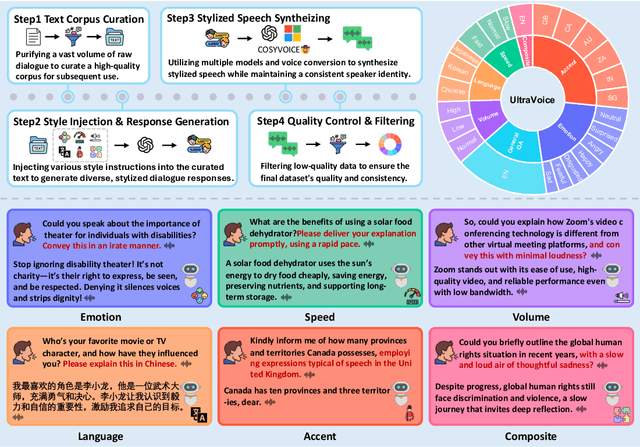

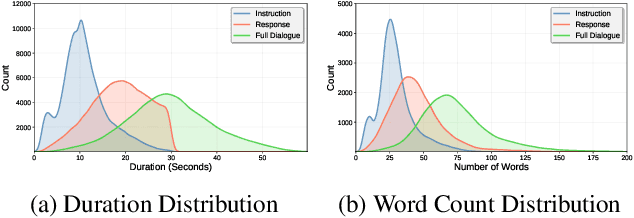

Abstract:Spoken dialogue models currently lack the ability for fine-grained speech style control, a critical capability for human-like interaction that is often overlooked in favor of purely functional capabilities like reasoning and question answering. To address this limitation, we introduce UltraVoice, the first large-scale speech dialogue dataset engineered for multiple fine-grained speech style control. Encompassing over 830 hours of speech dialogues, UltraVoice provides instructions across six key speech stylistic dimensions: emotion, speed, volume, accent, language, and composite styles. Fine-tuning leading models such as SLAM-Omni and VocalNet on UltraVoice significantly enhances their fine-grained speech stylistic controllability without degrading core conversational abilities. Specifically, our fine-tuned models achieve improvements of 29.12-42.33% in Mean Opinion Score (MOS) and 14.61-40.09 percentage points in Instruction Following Rate (IFR) on multi-dimensional control tasks designed in the UltraVoice. Moreover, on the URO-Bench benchmark, our fine-tuned models demonstrate substantial gains in core understanding, reasoning, and conversational abilities, with average improvements of +10.84% on the Basic setting and +7.87% on the Pro setting. Furthermore, the dataset's utility extends to training controllable Text-to-Speech (TTS) models, underscoring its high quality and broad applicability for expressive speech synthesis. The complete dataset and model checkpoints are available at: https://github.com/bigai-nlco/UltraVoice.
The Universal Landscape of Human Reasoning
Oct 24, 2025Abstract:Understanding how information is dynamically accumulated and transformed in human reasoning has long challenged cognitive psychology, philosophy, and artificial intelligence. Existing accounts, from classical logic to probabilistic models, illuminate aspects of output or individual modelling, but do not offer a unified, quantitative description of general human reasoning dynamics. To solve this, we introduce Information Flow Tracking (IF-Track), that uses large language models (LLMs) as probabilistic encoder to quantify information entropy and gain at each reasoning step. Through fine-grained analyses across diverse tasks, our method is the first successfully models the universal landscape of human reasoning behaviors within a single metric space. We show that IF-Track captures essential reasoning features, identifies systematic error patterns, and characterizes individual differences. Applied to discussion of advanced psychological theory, we first reconcile single- versus dual-process theories in IF-Track and discover the alignment of artificial and human cognition and how LLMs reshaping human reasoning process. This approach establishes a quantitative bridge between theory and measurement, offering mechanistic insights into the architecture of reasoning.
Omni-Captioner: Data Pipeline, Models, and Benchmark for Omni Detailed Perception
Oct 14, 2025Abstract:Fine-grained perception of multimodal information is critical for advancing human-AI interaction. With recent progress in audio-visual technologies, Omni Language Models (OLMs), capable of processing audio and video signals in parallel, have emerged as a promising paradigm for achieving richer understanding and reasoning. However, their capacity to capture and describe fine-grained details remains limited explored. In this work, we present a systematic and comprehensive investigation of omni detailed perception from the perspectives of the data pipeline, models, and benchmark. We first identify an inherent "co-growth" between detail and hallucination in current OLMs. To address this, we propose Omni-Detective, an agentic data generation pipeline integrating tool-calling, to autonomously produce highly detailed yet minimally hallucinatory multimodal data. Based on the data generated with Omni-Detective, we train two captioning models: Audio-Captioner for audio-only detailed perception, and Omni-Captioner for audio-visual detailed perception. Under the cascade evaluation protocol, Audio-Captioner achieves the best performance on MMAU and MMAR among all open-source models, surpassing Gemini 2.5 Flash and delivering performance comparable to Gemini 2.5 Pro. On existing detailed captioning benchmarks, Omni-Captioner sets a new state-of-the-art on VDC and achieves the best trade-off between detail and hallucination on the video-SALMONN 2 testset. Given the absence of a dedicated benchmark for omni detailed perception, we design Omni-Cloze, a novel cloze-style evaluation for detailed audio, visual, and audio-visual captioning that ensures stable, efficient, and reliable assessment. Experimental results and analysis demonstrate the effectiveness of Omni-Detective in generating high-quality detailed captions, as well as the superiority of Omni-Cloze in evaluating such detailed captions.
Beyond Surface Reasoning: Unveiling the True Long Chain-of-Thought Capacity of Diffusion Large Language Models
Oct 10, 2025Abstract:Recently, Diffusion Large Language Models (DLLMs) have offered high throughput and effective sequential reasoning, making them a competitive alternative to autoregressive LLMs (ALLMs). However, parallel decoding, which enables simultaneous token updates, conflicts with the causal order often required for rigorous reasoning. We first identify this conflict as the core Parallel-Sequential Contradiction (PSC). Behavioral analyses in both simple and complex reasoning tasks show that DLLMs exhibit genuine parallelism only for directly decidable outputs. As task difficulty increases, they revert to autoregressive-like behavior, a limitation exacerbated by autoregressive prompting, which nearly doubles the number of decoding steps with remasking without improving quality. Moreover, PSC restricts DLLMs' self-reflection, reasoning depth, and exploratory breadth. To further characterize PSC, we introduce three scaling dimensions for DLLMs: parallel, diffusion, and sequential. Empirically, while parallel scaling yields consistent improvements, diffusion and sequential scaling are constrained by PSC. Based on these findings, we propose several practical mitigations, parallel-oriented prompting, diffusion early stopping, and parallel scaling, to reduce PSC-induced ineffectiveness and inefficiencies.
Towards Responsible Evaluation for Text-to-Speech
Oct 08, 2025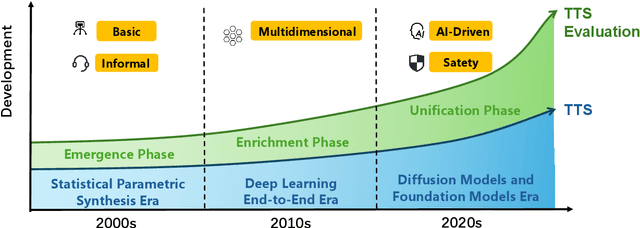



Abstract:Recent advances in text-to-speech (TTS) technology have enabled systems to produce human-indistinguishable speech, bringing benefits across accessibility, content creation, and human-computer interaction. However, current evaluation practices are increasingly inadequate for capturing the full range of capabilities, limitations, and societal implications. This position paper introduces the concept of Responsible Evaluation and argues that it is essential and urgent for the next phase of TTS development, structured through three progressive levels: (1) ensuring the faithful and accurate reflection of a model's true capabilities, with more robust, discriminative, and comprehensive objective and subjective scoring methodologies; (2) enabling comparability, standardization, and transferability through standardized benchmarks, transparent reporting, and transferable evaluation metrics; and (3) assessing and mitigating ethical risks associated with forgery, misuse, privacy violations, and security vulnerabilities. Through this concept, we critically examine current evaluation practices, identify systemic shortcomings, and propose actionable recommendations. We hope this concept of Responsible Evaluation will foster more trustworthy and reliable TTS technology and guide its development toward ethically sound and societally beneficial applications.
UniVoice: Unifying Autoregressive ASR and Flow-Matching based TTS with Large Language Models
Oct 06, 2025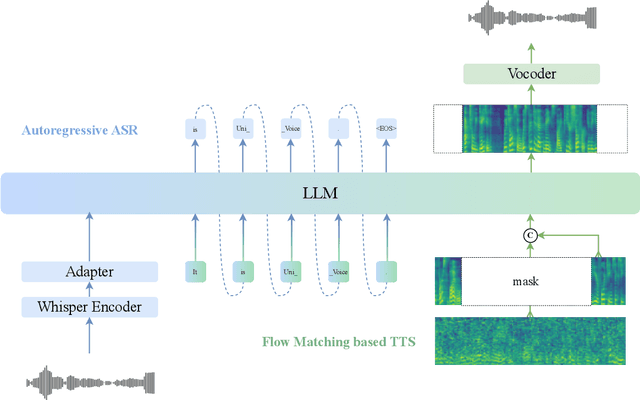
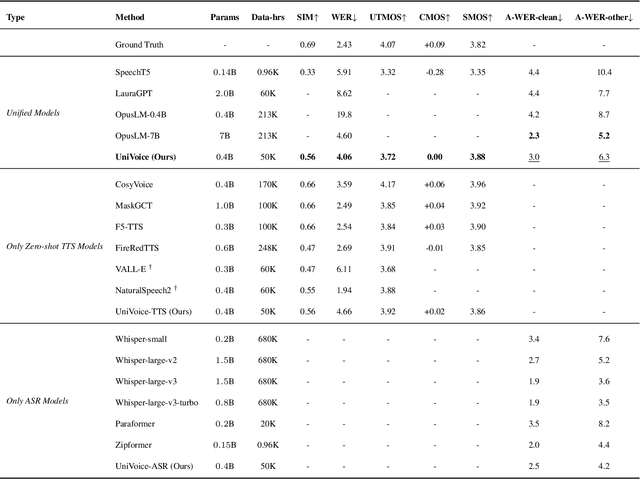
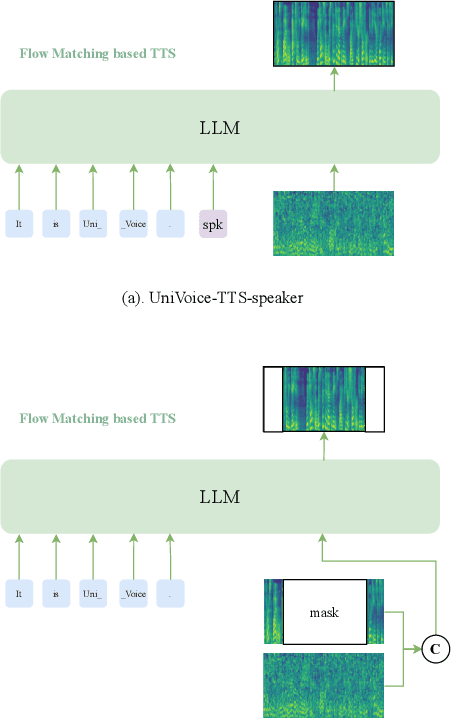

Abstract:Large language models (LLMs) have demonstrated promising performance in both automatic speech recognition (ASR) and text-to-speech (TTS) systems, gradually becoming the mainstream approach. However, most current approaches address these tasks separately rather than through a unified framework. This work aims to integrate these two tasks into one unified model. Although discrete speech tokenization enables joint modeling, its inherent information loss limits performance in both recognition and generation. In this work, we present UniVoice, a unified LLM framework through continuous representations that seamlessly integrates speech recognition and synthesis within a single model. Our approach combines the strengths of autoregressive modeling for speech recognition with flow matching for high-quality generation. To mitigate the inherent divergence between autoregressive and flow-matching models, we further design a dual attention mechanism, which switches between a causal mask for recognition and a bidirectional attention mask for synthesis. Furthermore, the proposed text-prefix-conditioned speech infilling method enables high-fidelity zero-shot voice cloning. Experimental results demonstrate that our method can achieve or exceed current single-task modeling methods in both ASR and zero-shot TTS tasks. This work explores new possibilities for end-to-end speech understanding and generation.
Semantic-VAE: Semantic-Alignment Latent Representation for Better Speech Synthesis
Sep 26, 2025Abstract:While mel-spectrograms have been widely utilized as intermediate representations in zero-shot text-to-speech (TTS), their inherent redundancy leads to inefficiency in learning text-speech alignment. Compact VAE-based latent representations have recently emerged as a stronger alternative, but they also face a fundamental optimization dilemma: higher-dimensional latent spaces improve reconstruction quality and speaker similarity, but degrade intelligibility, while lower-dimensional spaces improve intelligibility at the expense of reconstruction fidelity. To overcome this dilemma, we propose Semantic-VAE, a novel VAE framework that utilizes semantic alignment regularization in the latent space. This design alleviates the reconstruction-generation trade-off by capturing semantic structure in high-dimensional latent representations. Extensive experiments demonstrate that Semantic-VAE significantly improves synthesis quality and training efficiency. When integrated into F5-TTS, our method achieves 2.10% WER and 0.64 speaker similarity on LibriSpeech-PC, outperforming mel-based systems (2.23%, 0.60) and vanilla acoustic VAE baselines (2.65%, 0.59). We also release the code and models to facilitate further research.
AUV: Teaching Audio Universal Vector Quantization with Single Nested Codebook
Sep 26, 2025Abstract:We propose AUV, a unified neural audio codec with a single codebook, which enables a favourable reconstruction of speech and further extends to general audio, including vocal, music, and sound. AUV is capable of tackling any 16 kHz mixed-domain audio segment at bit rates around 700 bps. To accomplish this, we guide the matryoshka codebook with nested domain-specific partitions, assigned with corresponding teacher models to perform distillation, all in a single-stage training. A conformer-style encoder-decoder architecture with STFT features as audio representation is employed, yielding better audio quality. Comprehensive evaluations demonstrate that AUV exhibits comparable audio reconstruction ability to state-of-the-art domain-specific single-layer quantizer codecs, showcasing the potential of audio universal vector quantization with a single codebook. The pre-trained model and demo samples are available at https://swivid.github.io/AUV/.
Bitrate-Controlled Diffusion for Disentangling Motion and Content in Video
Sep 10, 2025Abstract:We propose a novel and general framework to disentangle video data into its dynamic motion and static content components. Our proposed method is a self-supervised pipeline with less assumptions and inductive biases than previous works: it utilizes a transformer-based architecture to jointly generate flexible implicit features for frame-wise motion and clip-wise content, and incorporates a low-bitrate vector quantization as an information bottleneck to promote disentanglement and form a meaningful discrete motion space. The bitrate-controlled latent motion and content are used as conditional inputs to a denoising diffusion model to facilitate self-supervised representation learning. We validate our disentangled representation learning framework on real-world talking head videos with motion transfer and auto-regressive motion generation tasks. Furthermore, we also show that our method can generalize to other types of video data, such as pixel sprites of 2D cartoon characters. Our work presents a new perspective on self-supervised learning of disentangled video representations, contributing to the broader field of video analysis and generation.
MeanAudio: Fast and Faithful Text-to-Audio Generation with Mean Flows
Aug 08, 2025Abstract:Recent developments in diffusion- and flow- based models have significantly advanced Text-to-Audio Generation (TTA). While achieving great synthesis quality and controllability, current TTA systems still suffer from slow inference speed, which significantly limits their practical applicability. This paper presents MeanAudio, a novel MeanFlow-based model tailored for fast and faithful text-to-audio generation. Built on a Flux-style latent transformer, MeanAudio regresses the average velocity field during training, enabling fast generation by mapping directly from the start to the endpoint of the flow trajectory. By incorporating classifier-free guidance (CFG) into the training target, MeanAudio incurs no additional cost in the guided sampling process. To further stabilize training, we propose an instantaneous-to-mean curriculum with flow field mix-up, which encourages the model to first learn the foundational instantaneous dynamics, and then gradually adapt to mean flows. This strategy proves critical for enhancing training efficiency and generation quality. Experimental results demonstrate that MeanAudio achieves state-of-the-art performance in single-step audio generation. Specifically, it achieves a real time factor (RTF) of 0.013 on a single NVIDIA RTX 3090, yielding a 100x speedup over SOTA diffusion-based TTA systems. Moreover, MeanAudio also demonstrates strong performance in multi-step generation, enabling smooth and coherent transitions across successive synthesis steps.
 Add to Chrome
Add to Chrome Add to Firefox
Add to Firefox Add to Edge
Add to Edge